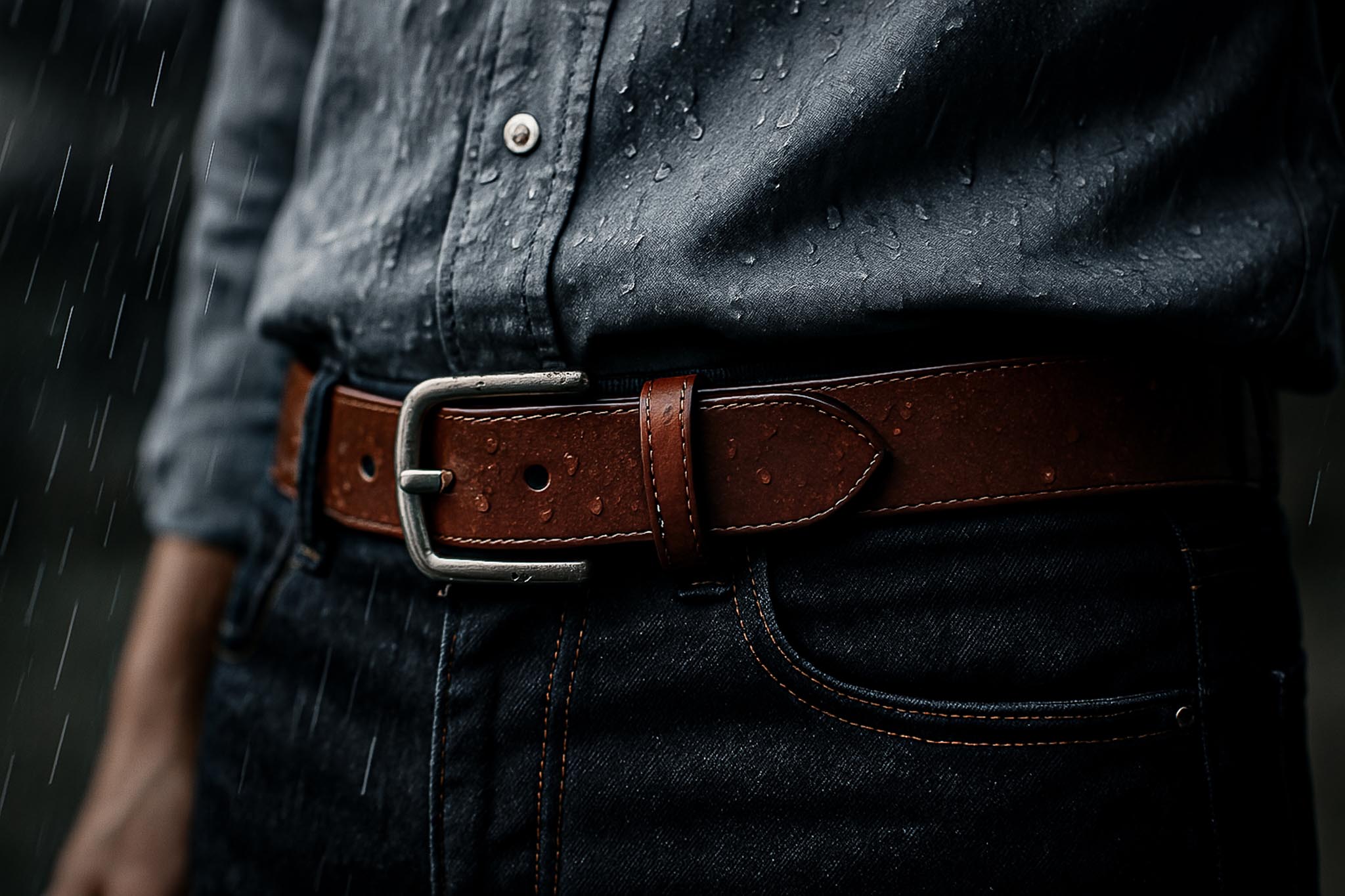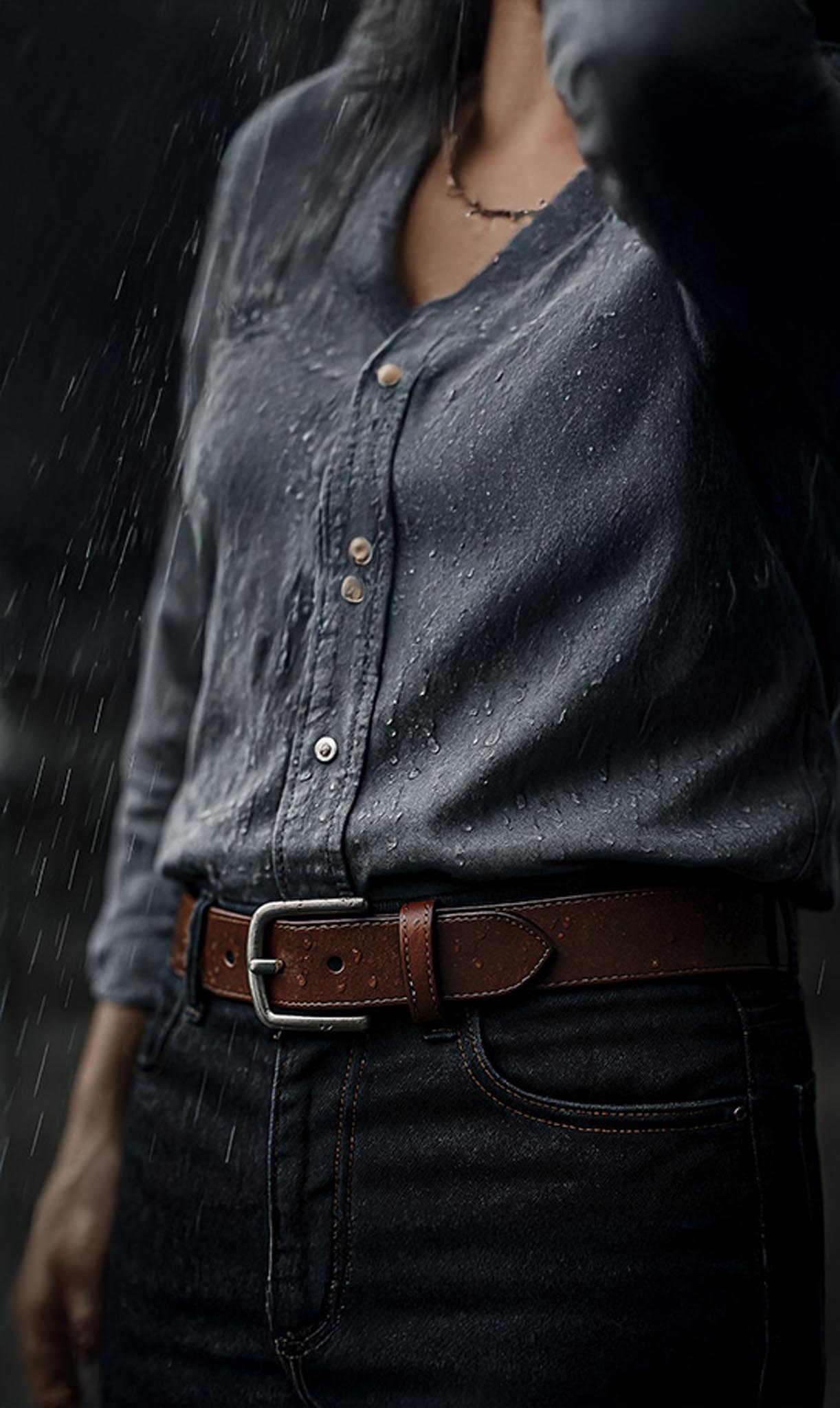Can You Wear a Leather Belt in the Rain? Risks and Practical Tips
What to do if your belt gets wet


Can You Wear a Leather Belt in the Rain? Risks and Practical Tips
What to do if your belt gets wet
Natural leather is sensitive to moisture: rain can damage its structure, cause warping, and ruin its appearance. This article explores when rain is harmless, how to care for wet leather, and how to protect your belt in advance.
Leather belts are widely appreciated for their durability and expressive aesthetic. They work equally well with everyday outfits and formal wear, adding a sense of structure and finish. However, despite their many advantages, natural leather reacts to changing weather conditions in specific ways. One question that often arises is whether it's safe to wear a leather belt in the rain - and if so, under what circumstances and precautions.
How Does Rain Affect Leather?
Natural leather is an organic, breathable material with a porous structure. It absorbs moisture, and once wet, its internal structure changes on a microscopic level. Water softens the leather, reducing its elasticity. If the leather is not dried or treated correctly afterward, this exposure can lead to long-term damage.

Common effects of water exposure:
- Deformation - the belt may stretch, warp, or retain bends and creases, especially in high-tension areas;
- Surface changes - visible spots, watermarks, and darkening may appear, particularly on light-colored or unfinished leather;
- Drying issues - leather may become stiff, brittle, or develop cracks if not properly moisturized after drying.
Frequent water exposure - especially without follow-up care - can significantly reduce the lifespan of even high-quality leather belts and diminish their appearance over time.
When Is Rain Less of a Threat?
Some belts are more resistant to moisture, especially if they were crafted with durability in mind. This is especially true for leather goods designed in the tradition of saddle-making or outdoor gear.

Factors that help a belt resist water damage:
- Deep treatment with oils or waxes during production - these substances penetrate the leather and form a water-repellent barrier;
- Protective topcoats - a finishing layer of lacquer or waterproofing solution slows down water absorption;
- Regular application of leather-care products - water-repellent sprays, balms, or conditioners enhance the leather’s resistance over time.
However, even with solid protection, leather is not waterproof by nature. These treatments delay water absorption, giving you time to react - seek shelter or switch out the belt before damage sets in.
What to Do If Your Belt Gets Wet
Even if your belt ends up soaked during a heavy rainstorm, there's a good chance you can restore it - if you act quickly and carefully. Natural leather is highly responsive to proper care, especially when dried at a gentle pace and reconditioned afterward.

Step-by-step recovery:
- Take the belt off as soon as you're indoors. Don't leave it on your body - body heat and moisture accelerate leather softening and deformation.
- Blot away moisture with a soft, dry cloth. Avoid rubbing or scrubbing - the friction can damage the surface and leave lasting marks.
- Let the belt air-dry naturally. Keep it away from heaters, radiators, or direct sunlight. Rapid drying causes leather to lose moisture unevenly and may lead to cracking.
- Once fully dry, apply a leather conditioner or nourishing oil. This restores the leather’s flexibility, sheen, and color depth.
With the right treatment, most leather belts can survive unexpected rain without lasting damage.
How to Prevent Damage: Care and Precaution
Preventative care is far more effective than reactive fixes. Taking a few simple steps can extend your leather belt’s life and preserve its appearance.

Key recommendations:
- Apply water-repellent treatments regularly. Especially important if you live in a rainy climate or often spend time outdoors. These products add a subtle protective layer against moisture and dirt.
- Rotate your belts based on conditions. Keep one high-end belt for special occasions and another, more rugged option for uncertain weather. This helps preserve premium leather over time.
- Store belts in a cool, dry, and well-ventilated place. Avoid sealed boxes or sun-exposed areas. Hanging the belt or storing it flat helps maintain its shape.
- Condition the leather every month or two. Even if the belt hasn’t been exposed to water, leather naturally loses moisture and needs replenishment to stay supple and crack-free.
Before You Head Out into the Rain

Wearing a leather belt in the rain is possible - but it requires some thought and care. If the belt is properly treated and you’re prepared to look after it afterward, occasional moisture won’t be a serious problem. That said, natural leather responds best to mindful use. With preparation, quick reaction, and regular maintenance, your belt can continue to look and perform its best, rain or shine. Taking care of leather is an investment in longevity and craftsmanship - and the results are always worth it.
Our other posts






